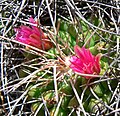| Mammillaria compressa | |
|---|---|

| |
|
Scientific classification
| |
| Kingdom: | Plantae |
| Clade: | Tracheophytes |
| Clade: | Angiosperms |
| Clade: | Eudicots |
| Order: | Caryophyllales |
| Family: | Cactaceae |
| Subfamily: | Cactoideae |
| Genus: | Mammillaria |
| Species: | M. compressa
|
| Binomial name | |
| Mammillaria compressa
DC., 1828
| |
Mammillaria compressa, commonly called mother of hundreds, is a species of cactus in the subfamily Cactoideae. [1] It is native to northern and southern Mexico, and is cultivated as an ornamental plant. [1] It blooms in the winter and early spring, with bell-shaped flowers that range from a purplish pink to red color. [2] Its curved spines were traditionally used as hooks for fishing. [2]
Gallery
-
Flower detail
-
Mammillaria compressa at the botanical garden in Berlin
References
- ^ a b Wiersema, John H.; León, Blanca (2016). World Economic Plants: A Standard Reference, Second Edition. Boca Raton: CRC Press. p. 431. ISBN 978-1466576810. Retrieved 17 February 2020 – via GoogleBooks.
- ^ a b "Mammillaria compressa". LLIFLE. 14 November 2005. Retrieved 17 February 2020.
| Mammillaria compressa | |
|---|---|

| |
|
Scientific classification
| |
| Kingdom: | Plantae |
| Clade: | Tracheophytes |
| Clade: | Angiosperms |
| Clade: | Eudicots |
| Order: | Caryophyllales |
| Family: | Cactaceae |
| Subfamily: | Cactoideae |
| Genus: | Mammillaria |
| Species: | M. compressa
|
| Binomial name | |
| Mammillaria compressa
DC., 1828
| |
Mammillaria compressa, commonly called mother of hundreds, is a species of cactus in the subfamily Cactoideae. [1] It is native to northern and southern Mexico, and is cultivated as an ornamental plant. [1] It blooms in the winter and early spring, with bell-shaped flowers that range from a purplish pink to red color. [2] Its curved spines were traditionally used as hooks for fishing. [2]
Gallery
-
Flower detail
-
Mammillaria compressa at the botanical garden in Berlin
References
- ^ a b Wiersema, John H.; León, Blanca (2016). World Economic Plants: A Standard Reference, Second Edition. Boca Raton: CRC Press. p. 431. ISBN 978-1466576810. Retrieved 17 February 2020 – via GoogleBooks.
- ^ a b "Mammillaria compressa". LLIFLE. 14 November 2005. Retrieved 17 February 2020.




